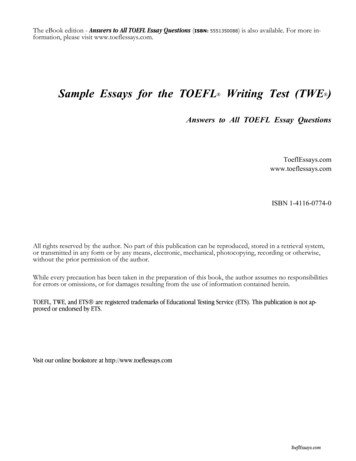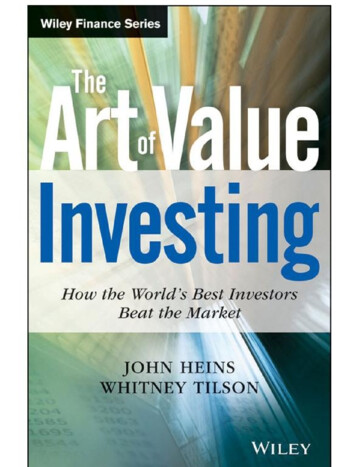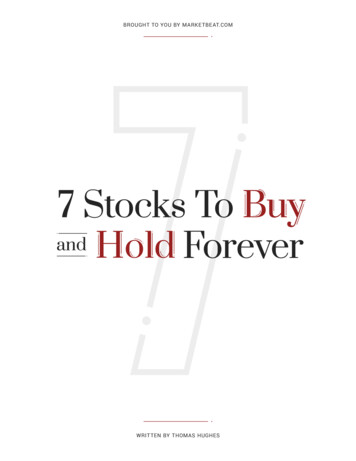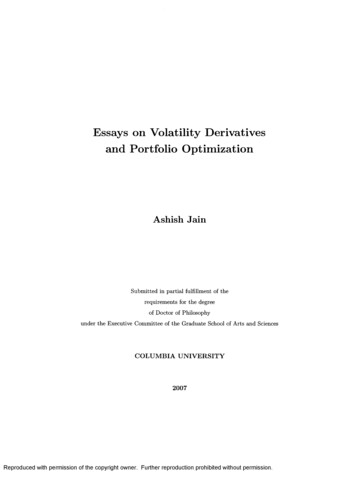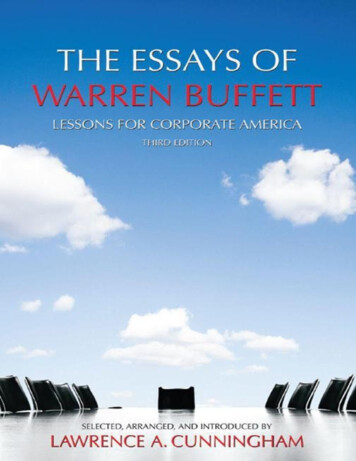
Transcription
THE ESSAYS OF WARREN BUFFETT:LESSONS FOR CORPORATE AMERICA
THE ESSAYS OF WARREN BUFFETT:LESSONS FOR CORPORATE AMERICAESSAYS BYWARREN E. BUFFETTSELECTED, ARRANGED, AND INTRODUCED BYLAWRENCE A. CUNNINGHAMTHIRD EDITION
Library of Congress Cataloging-in-Publication Data eISBN: 978-1-61163447-1Cunningham, Lawrence A., 1962Buffett, Warren E., 1930-The Essays of Warren Buffett: Lessons for CorporateAmerica / selected, arranged, and introduced by Lawrence A. Cunningham—3ded.308 p. 26 cm.Includes previously copyrighted material. Reprinted with permission.Includes bibliographical references and index.1. Corporations—United States—Finance. 2. Corporate governance—United States. 3. Investments—United States. 4. Stocks—United States. 5.Consolidation and merger of corporations—United States. 6. Accounting—United States. I. Buffett, Warren E. II. Cunningham, Lawrence A. III. Title.HG4061.B8372 2001(OCoLC) 38497313Originally published as part of the Cardozo Law Review’s special issue on TheEssays of Warren Buffett Symposium. Copyright Lawrence A. Cunningham,1997, 2001, 2008, and 2013. Includes previously copyrighted materials, Warren E. Buffett, reprinted with permission. All rights reserved. Printed in theUnited States of America.ISBN: 978-1-61163-409-9Copies of this collection are available in larger quantities at special discounts touse for teaching, training, promotions, premiums or other purposes. For moreinformation, please contact Carolina Academic Press, 700 Kent Street, Durham,NC 27701, http://www.cap-press.com.
“The speech I love is a simple, natural speech, the same on paper as in themouth; a speech succulent and sinewy, brief and compressed, not so much daintyand well-combed as vehement and brusque.”Michel de MontaigneThe Essays of Montaigne(1580)“The sincerity and marrow of the man reaches to his sentences.I know not anywhere a book that seems less written.Cut these words and they would bleed; they are vascular and alive.”Ralph Waldo EmersonRepresentative Man(1850)(Referring to Montaigneand his Essays)
TABLE OF CONTENTSPREFACEINTRODUCTIONPROLOGUE: OWNER-RELATED BUSINESS PRINCIPLESI. CORPORATE GOVERNANCEA. Full and Fair DisclosureB. Boards and ManagersC. The Anxieties of Business ChangeD. Social CompactsE. An Owner-Based Approach to Corporate CharityF. A Principled Approach to Executive PayG. Risk, Reputation and OversightII. FINANCE AND INVESTINGA. Mr. MarketB. ArbitrageC. Debunking Standard DogmaD. “Value” Investing: A RedundancyE. Intelligent InvestingF. Cigar Butts and the Institutional ImperativeG. Life and DebtIII. INVESTMENT ALTERNATIVESA. Surveying the FieldB. Junk BondsC. Zero-Coupon BondsD. Preferred StockE. DerivativesF. Foreign Currencies and EquitiesG. Home Ownership: Practice and PolicyIV. COMMON STOCKA. The Bane of Trading: Transaction CostsB. Attracting the Right Sort of Investor
C. Dividend Policy and Share RepurchasesD. Stock Splits and Trading ActivityE. Shareholder StrategiesF. Berkshire’s RecapitalizationV. MERGERS AND ACQUISITIONSA. Bad Motives and High PricesB. Sensible Share Repurchases Versus GreenmailC. Leveraged BuyoutsD. Sound Acquisition PoliciesE. On Selling One’s BusinessF. The Buyer of ChoiceVI. VALUATION AND ACCOUNTINGA. Aesop and Inefficient Bush TheoryB. Intrinsic Value, Book Value, and Market PriceC. Look-Through EarningsD. Economic versus Accounting GoodwillE. Owner Earnings and the Cash Flow FallacyF. Option ValuationVII. ACCOUNTING SHENANIGANSA. A Satire on Accounting ShenanigansB. Standard SettingC. Stock OptionsD. “Restructuring” ChargesE. Pension EstimatesF. Realization EventsVIII. ACCOUNTING POLICYA. MergersB. Segment Data and ConsolidationC. Deferred TaxesD. Retiree BenefitsIX. TAX MATTERSA. Distribution of the Corporate Tax BurdenB. Taxation and Investment PhilosophyEPILOGUE
INDEXCONCEPT GLOSSARYDISPOSITION SUMMARY
PREFACEThe original edition of The Essays of Warren Buffett: Lessons for CorporateAmerica was the centerpiece of a symposium held two decades ago at theBenjamin N. Cardozo School of Law under the auspices of its Samuel andRonnie Heyman Center on Corporate Governance. This gathering broughthundreds of Cardozo students together for a two-day dissection of all the ideas inthe collection, featuring a series of vibrant debates among some 30 distinguishedprofessors, investors, managers, and other students, with Warren E. Buffett andCharles T. Munger participating throughout from their seats in the front row.The Essays was the standard textbook for a specialized course I taught atCardozo in proper business practices and is adopted by scores of professors atother law and business schools for classes such as investment, finance andaccounting. Some investment firms have distributed copies to their professionalemployees and clients as part of training programs. I am grateful for the positivefeedback from these students, teachers, and other users and delighted to knowthat the lessons are being taught and learned. Special thanks to Professor TomJohansen (Ft. Hays State University, Kansas) and Professor Leo Chan (DelawareState College).Continuing thanks also to Mr. Buffett’s good friend and advisor, RobertDenham, whom I have had the pleasure of getting to know in the years followingthe symposium. Mr. Denham, a partner in the law firm Munger, Tolles & Olsen,introduced Mr. Buffett to Cardozo and me through another mutual friend, formerMunger, Tolles colleague and now Cardozo professor Monroe Price, and I thankboth of them for opening that door. Thanks also to Carol Loomis, a close friendof Mr. Buffett’s and the person who annually edits each shareholder letter. Forinstitutional support in countless ways, thanks as always to Sam and RonnieHeyman.As in previous editions of The Essays, this one retains the architecture andphilosophy of the original edition but adds selections from Mr. Buffett’s mostrecent annual shareholder letters. All the letters are woven together into a fabricthat reads as a complete and coherent narrative of a sound business andinvestment philosophy. As an aid to all readers, and to enable readers of theprevious editions to see what is new in this one, a disposition table at the end ofthe book shows the various places in this collection where selections from eachyear’s letter appear. Footnotes throughout indicate the year of the annual report
from which essays are taken. To avoid interrupting the narrative flow in thiscollection, omissions of text within excerpts are not indicated by ellipses or otherpunctuation.The new edition is called for not because anything has changed about thefundamentals of sound business and investment philosophy but because Mr.Buffett’s articulation of that philosophy is always done in the context ofcontemporary events and business conditions. So periodic updating is warrantedto maintain its currency.In preparing the previous editions, I was aided by numerous people, towhom I expressed gratitude in those editions, and I want to thank them again.Among those, I especially thank Mr. Buffett. His generosity not only made thesymposium possible but his participation enriched it manifold; his willingness toentrust the rearrangement and republication of his letters to me is a great honor.His partner, Charlie Munger, deserves repeated thanks too, for not only did heparticipate in the symposium from the front row he also graciously chaired, on amoment’s notice, one of the panels.Lawrence A. Cunningham
New York CityFebruary 2, 2013
INTRODUCTIONLawrence A. CunninghamExperienced readers of Warren Buffett’s letters to the shareholders ofBerkshire Hathaway Inc. have gained an enormously valuable informaleducation. The letters distill in plain words all the basic principles of soundbusiness practices. On selecting managers and investments, valuing businesses,and using financial information profitably, the writings are broad in scope, andlong on wisdom. By arranging these writings as thematic essays, this collectionpresents a synthesis of the overall business and investment philosophy intendedfor dissemination to a wide general audience.The central theme uniting Buffett’s lucid essays is that the principles offundamental business analysis, first formulated by his teachers Ben Graham andDavid Dodd, should guide investment practice. Linked to that theme aremanagement principles that define the proper role of corporate managers as thestewards of invested capital, and the proper role of shareholders as the suppliersand owners of capital. Radiating from these main themes are practical andsensible lessons on the entire range of important business issues, fromaccounting to mergers to valuation.Buffett has applied these traditional principles as chief executive officer ofBerkshire Hathaway, a company with roots in a group of textile operations begunin the early 1800s. Buffett took the helm of Berkshire in 1964, when its bookvalue per share was 19.46 and its intrinsic value per share far lower. Today, itsbook value per share is around 100,000 and its intrinsic value far higher. Thegrowth rate in book value per share during that period is about 20% compoundedannually.Berkshire is now a holding company engaged in 80 distinct business lines.Berkshire’s most important business is insurance, carried on through variouscompanies including its 100% owned subsidiary, GEICO Corporation, amongthe largest auto insurers in the United States, and General Re Corporation, one ofthe largest reinsurers in the world. In 2010, Berkshire acquired BurlingtonNorthern Santa Fe Corporation, among the largest railroads in North America,and has long owned and operated large energy companies. Some Berkshiresubsidiaries are massive: eight would be included in the Fortune 500 if they were
stand-alone companies. Its other interests are so vast that, as Buffett writes:“when you are looking at Berkshire, you are looking across corporate America.”Examples: food, clothing, building materials, tools, equipment, newspapers,books, transportation services and financial products. Berkshire also owns largeequity interests in major corporations, including American Express, Coca-Cola,International Business Machines (IBM), Procter & Gamble (through merger withlongtime holdings in Gillette), The Washington Post, and Wells Fargo.Buffett and Berkshire Vice Chairman Charlie Munger have built thissprawling enterprise by investing in businesses with excellent economiccharacteristics and run by outstanding managers. While they prefer negotiatedacquisitions of 100% of such a business at a fair price, they take a “doublebarreled approach” of buying on the open market less than 100% of somebusinesses when they can do so at a pro-rata price well below what it would taketo buy 100%.The double-barreled approach pays off handsomely. The value ofmarketable securities in Berkshire’s portfolio, on a per share basis, increasedfrom 4 in 1965 to 95,000 in 2010, a 20% compound annual increase. Per shareoperating earnings increased in the same period from just over 4 to nearly 6,000, a compound annual increase of about 21%. According to Buffett, theseresults follow not from any master plan but from focused investing—allocatingcapital by concentrating on businesses with outstanding economic characteristicsand run by firstrate managers.Buffett views Berkshire as a partnership among him, Munger and othershareholders, and virtually all his net worth is in Berkshire stock. His economicgoal is long-term—to maximize Berkshire’s per share intrinsic value by owningall or part of a diversified group of businesses that generate cash and aboveaverage returns. In achieving this goal, Buffett foregoes expansion for the sakeof expansion and foregoes divestment of businesses so long as they generatesome cash and have good management.Berkshire retains and reinvests earnings when doing so delivers at leastproportional increases in per share market value over time. It uses debt sparinglyand sells equity only when it receives as much in value as it gives. Buffettpenetrates accounting conventions, especially those that obscure real economicearnings.These owner-related business principles, as Buffett calls them, are theorganizing themes of the accompanying essays. As organized, the essaysconstitute an elegant and instructive manual on management, investment,
finance, and accounting. Buffett’s basic principles form the framework for a richrange of positions on the wide variety of issues that exist in all aspects ofbusiness. They go far beyond mere abstract platitudes. It is true that investorsshould focus on fundamentals, be patient, and exercise good judgment based oncommon sense. In Buffett’s essays, these advisory tidbits are anchored in themore concrete principles by which Buffett lives and thrives.CORPORATE GOVERNANCEFor Buffett, managers are stewards of shareholder capital. The bestmanagers think like owners in making business decisions. They haveshareholder interests at heart. But even firstrate managers will sometimes haveinterests that conflict with those of shareholders. How to ease those conflicts andto nurture managerial stewardship have been constant objectives of Buffett’slong career and a prominent theme of his essays. The essays address some of themost important governance problems.The first is the importance of forthrightness and candor in communicationsby managers to shareholders. Buffett tells it like it is, or at least as he sees it, andlaments that he is in the minority. Berkshire’s annual report is not glossy; Buffettprepares its contents using words and numbers people of average intelligencecan understand; and all investors get the same information at the same time.Buffett and Berkshire avoid making predictions, a bad managerial habit that toooften leads other managers to make up their financial reports.Besides the owner-orientation reflected in Buffett’s disclosure practice andthe owner-related business principles summarized above, the next managementlesson is to dispense with formulas of managerial structure. Contrary to textbookrules on organizational behavior, mapping an abstract chain of command on to aparticular business situation, according to Buffett, does little good. What mattersis selecting people who are able, honest, and hard-working. Having firstratepeople on the team is more important than designing hierarchies and clarifyingwho reports to whom about what and at what times.Special attention must be paid to selecting a chief executive officer (CEO)because of three major differences Buffett identifies between CEOs and otheremployees. First, standards for measuring a CEO’s performance are inadequateor easy to manipulate, so a CEO’s performance is harder to measure than that ofmost workers. Second, no one is senior to the CEO, so no senior person’sperformance can be measured either. Third, a board of directors cannot serve thatsenior role since relations between CEOs and boards are conventionallycongenial.
Major reforms are often directed toward aligning management andshareholder interests or enhancing board oversight of CEO performance. Stockoptions for management were touted as one method; greater emphasis on boardprocesses was another. Separating the identities and functions of the Chairman ofthe Board and the CEO or appointment of standing audit, nominating andcompensation committees were also heralded as promising reforms. Perhaps themost pervasive prescription is to populate boards with independent directors.None of these innovations has solved governance problems, however, and somehave exacerbated them.The best solution, Buffett instructs, is to take great care in identifying CEOswho will perform capably regardless of weak structural restraints. Largeinstitutional shareholders must exercise their power to oust CEOs that do notmeasure up to the demands of corporate stewardship. Outstanding CEOs do notneed a lot of coaching from owners, although they can benefit from having asimilarly outstanding board. Directors therefore must be chosen for theirbusiness savvy, their interest, and their owner-orientation. According to Buffett,one of the greatest problems among boards in corporate America is thatmembers are selected for other reasons, such as adding diversity or prominenceto a board—or, famously, independence.Most reforms are painted with a broad brush, without noting the majordifferences among types of board situations that Buffett identifies. For example,director power is weakest in the case where there is a controlling shareholderwho is also the manager. When disagreements arise between the directors andmanagement, there is little a director can do other than to object and, in seriouscircumstances, resign. Director power is strongest at the other extreme, wherethere is a controlling shareholder who does not participate in management. Thedirectors can take matters directly to the controlling shareholder whendisagreement arises.The most common situation, however, is a corporation without a controllingshareholder. This is where management problems are most acute, Buffett says. Itwould be helpful if directors could supply necessary discipline, but boardcongeniality usually prevents that. To maximize board effectiveness in thissituation, Buffett believes the board should be small in size and composedmostly of outside directors. The strongest weapon a director can wield in thesesituations remains his or her threat to resign.All these situations do share a common characteristic: the terrible manageris a lot easier to confront or remove than the mediocre manager. A chief problemin all governance structures, Buffett emphasizes, is that in corporate Americaevaluation of chief executive officers is never conducted in regular meetings in
the absence of that chief executive. Holding regular meetings without the chiefexecutive to review his or her performance would be a marked improvement incorporate governance.The CEOs at Berkshire’s various operating companies enjoy a uniqueposition in corporate America. They are given a simple set of commands: to runtheir business as if (1) they are its sole owner, (2) it is the only asset they hold,and (3) they can never sell or merge it for a hundred years. This enablesBerkshire CEOs to manage with a long-term horizon ahead of them, somethingalien to the CEOs of public companies whose short-term oriented shareholdersobsess with meeting the latest quarterly earnings estimate. Short-term resultsmatter, of course, but the Berkshire approach avoids any pressure to achievethem at the expense of strengthening long-term competitive advantages.If only short-term results mattered, many managerial decisions would bemuch easier, particularly those relating to businesses whose economiccharacteristics have eroded. Consider the time horizon trade-off Buffett faced inmanaging what he considers the worst investment he ever made, buyingBerkshire in the first place. The economic characteristics of Berkshire’s oldtextile business had begun to erode by the late 1970s. Buffett had hoped todevise a reversal of its misfortunes, noting how important Berkshire’s textilebusiness was to its employees and local communities in New England, and howable and understanding management and labor had been in addressing theeconomic difficulties. Buffett kept the ailing plant alive through 1985, but afinancial reversal could not be achieved and Buffett eventually closed it. Thisbalancing of short-term results with long-term prospects based on communitytrust is not easy, but it is intelligent. Kindred lessons carry over to other sectorsin which Berkshire invests, such as the newspaper business in the internet age,and highly regulated industries, such as energy and railroads, in which Buffettsees an implicit social compact between private enterprise and regulatoryoverseers.Sometimes management interests conflict with shareholder interests insubtle or easily disguised ways. Take corporate philanthropy, for example. Atmost major corporations, management allocates a portion of corporate profit tocharitable concerns. The charities are chosen by management, for reasons oftenunrelated either to corporate interests or shareholder interests. Most state lawspermit management to make these decisions, so long as aggregate annualdonations are reasonable in amount, usually not greater than 10% of annual netprofits.Berkshire does things differently. It makes no contributions at the parentcompany level and allows its subsidiaries to follow philanthropic policies they
had in effect before Berkshire acquired them. For two decades, moreover,Berkshire used an imaginative program through which its shareholdersdesignated the charities to which Berkshire would donate and in what amounts.Nearly all shareholders participated, donating tens of millions of dollars annuallyto thousands of different charities. Political controversy over the abortion issue,however, interfered with this program. Political activists organized boycotts ofBerkshire’s products to protest particular charitable donations that were made,destroying this feature of Berkshire’s “partnership” approach.The plan to align management and shareholder interests by awardingexecutives stock options not only was oversold, but also subtly disguised adeeper division between those interests that the options created. Manycorporations pay their managers stock options whose value increases simply byretention of earnings, rather than by superior deployment of capital. As Buffettexplains, however, simply by retaining and reinvesting earnings, managers canreport annual earnings increases without so much as lifting a finger to improvereal returns on capital. Stock options thus often rob shareholders of wealth andallocate the booty to executives. Moreover, once granted, stock options are oftenirrevocable, unconditional, and benefit managers without regard to individualperformance.It is possible to use stock options to instill a managerial culture thatencourages owner-like thinking, Buffett agrees. But the alignment will not beperfect. Shareholders are exposed to the downside risks of suboptimal capitaldeployment in a way that an option holder is not. Buffett therefore cautionsshareholders who are reading proxy statements about approving option plans tobe aware of the asymmetry in this kind of alignment. Many shareholdersrationally ignore proxy statements, but the abuse of stock options should be onthe front-burner of shareholders, particularly institutional investors thatperiodically engage in promoting corporate governance improvements.Buffett emphasizes that performance should be the basis for executive paydecisions. Executive performance should be measured by profitability, afterprofits are reduced by a charge for the capital employed in the relevant businessor earnings retained by it. If stock options are used, they should be related toindividual performance, rather than corporate performance, and priced based onbusiness value. Better yet, as at Berkshire, stock options should simply not bepart of an executive’s compensation. After all, exceptional managers who earncash bonuses based on the performance of their own business can simply buystock if they want to; if they do, they “truly walk in the shoes of owners,” Buffettsays. And owners’ interests are paramount on executive pay as with othercorporate governance topics Buffett addresses, such as risk management,
corporate compliance and financial reporting.FINANCE AND INVESTINGThe most revolutionary investing ideas of the past thirty-five years werethose called modern finance theory. This is an elaborate set of ideas that boildown to one simple and misleading practical implication: it is a waste of time tostudy individual investment opportunities in public securities. According to thisview, you will do better by randomly selecting a group of stocks for a portfolioby throwing darts at the stock tables than by thinking about whether individualinvestment opportunities make sense.One of modern finance theory’s main tenets is modern portfolio theory. Itsays that you can eliminate the peculiar risk of any security by holding adiversified portfolio—that is, it formalizes the folk slogan “don’t put all youreggs in one basket.” The risk that is left over is the only risk for which investorswill be compensated, the story goes.This leftover risk can be measured by a simple mathematical term—calledbeta—that shows how volatile the security is compared to the market. Betameasures this volatility risk well for securities that trade on efficient markets,where information about publicly traded securities is swiftly and accuratelyincorporated into prices. In the modern finance story, efficient markets rule.Reverence for these ideas was not limited to ivory tower academics, incolleges, universities, business schools, and law schools, but became standarddogma throughout financial America in the past thirty-five years, from WallStreet to Main Street. Many professionals still believe that stock market pricesalways accurately reflect fundamental values, that the only risk that matters isthe volatility of prices, and that the best way to manage that risk is to invest in adiversified group of stocks.Being part of a distinguished line of investors stretching back to Grahamand Dodd which debunks standard dogma by logic and experience, Buffettthinks most markets are not purely efficient and that equating volatility with riskis a gross distortion. Accordingly, Buffett worried that a whole generation ofMBAs and JDs, under the influence of modern finance theory, was at risk oflearning the wrong lessons and missing the important ones.A particularly costly lesson of modern finance theory came from theproliferation of portfolio insurance—a computerized technique for readjusting aportfolio in declining markets. The promiscuous use of portfolio insurancehelped precipitate the stock market crash of October 1987, as well as the marketbreak of October 1989. It nevertheless had a silver lining: it shattered the modern
finance story being told in business and law schools and faithfully beingfollowed by many on Wall Street.Ensuing market volatility could not be explained by modern finance theory,nor could mountainous other phenomena relating to the behavior of smallcapitalization stocks, high dividend-yield stocks, and stocks with low priceearnings ratios. The piece de resistance of market inefficiency was thetechnology and Internet stock bubble that blew up in the late 1990s and early2000s, marked by stock price gyrations that spasmodically bounced betweeneuphoria and gloom without the remotest nexus to business value. Growingnumbers of skeptics emerged to say that beta does not really measure theinvestment risk that matters, and that capital markets are really not efficientenough to make beta meaningful anyway.In stirring up the discussion, people started noticing Buffett’s record ofsuccessful investing and calling for a return to the Graham-Dodd approach toinvesting and business. After all, for more than forty years Buffett has generatedaverage annual returns of 20% or better, which double the market average. Formore than twenty years before that, Ben Graham’s Graham-Newman Corp. haddone the same thing. As Buffett emphasizes, the stunning performances atGraham-Newman and at Berkshire deserve respect: the sample sizes weresignificant; they were conducted over an extensive time period, and were notskewed by a few fortunate experiences; no data-mining was involved; and theperformances were longitudinal, not selected by hindsight.Threatened by Buffett’s performance, stubborn devotees of modern financetheory resorted to strange explanations for his success. Maybe he is just lucky—the monkey who typed out Hamlet—or maybe he has inside access toinformation that other investors do not. In dismissing Buffett, modern financeenthusiasts still insist that an investor’s best strategy is to diversify based onbetas or dart throwing, and constantly reconfigure one’s portfolio of investments.Buffett responds with a quip and some advice: the quip is that devotees ofhis investment philosophy should probably endow chaired professorships atcolleges and universities to ensure the perpetual teaching of efficient marketdogma; the advice is to ignore modern finance theory and other quasisophisticated views of the market and stick to investment knitting. That can bestbe done for many people through long-term investment in an index fund. Or itcan be done by conducting hard-headed analyses of businesses within aninvestor’s competence to evaluate. In that kind of thinking, the risk that mattersis not beta or volatility, but the possibility of loss or injury from an investment.Assessing that kind of investment risk requires thinking about a company’smanagement, products, competitors, and debt levels. The inquiry is whether
after-tax returns on an investment are at least equal to the purchasing power ofthe initial investment plus a fair rate of return. The primary relevant factors arethe long-term economic characteristics of a business, the quality and integrity ofits management, and future levels of taxation and inflation. Maybe these factorsare vague, particularly compared with the seductive precision of beta, but thepoint is that judgments about such matters cannot be avoided, except to aninvestor’s disadvantage.Buffett points out the absurdity of beta by observing that “a stock that hasdropped very sharply compared to the market . . . becomes ‘riskier’ at the lowerprice than it was at the higher price”—that is how beta measures risk. Equallyunhelpful, beta cannot distinguish the risk inherent in “a single-product toycompany selling pet rocks or hula hoops from another toy company whose soleproduct is Monopoly or Barbie.” But ordinary investors can make thosedistinctions by thinking about consumer behavior and the way consumerproducts companies compete, and can also figure out when a huge stock-pricedrop signa
books, transportation services and financial products. Berkshire also owns large equity interests in major corporations, including American Express, Coca-Cola, International Business Machines (IBM), Procter & Gamble (through merger with longtime hol
